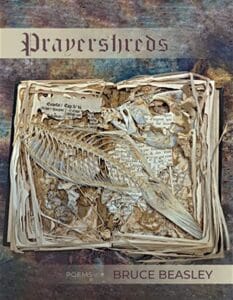Poet Bruce Beasley is in love with words and language
You read a poetry collection like Prayershreds by Bruce Beasley, and the first thing that strikes you is the language. Language should strike you in poetry, but in this case, you find yourself drowning in creativity and imagination. Throughout the entire collection, language appears to pour almost effortlessly like a fountain, and sometimes a flood. You almost think it’s stream-of-consciousness writing, and then you look closer. It’s anything but that, carefully considered and composed.
One poem incorporates musical notes. One invents a language like and unlike English, and while it’s at it reinvents physical form. Another uses a photograph of a sculpture by the artist Bruce Beasley (they share the name; I can imagine the poet grinning mischievously offstage).
The collection is about the standard length (roughly 80 pages) but contains only 18 poems. Two of the poems, “Disconnected Limbs Wandered Seeking Everywhere for Union” and “Not Easily Pulled Asunder: Ten for Tenacity,” are eight and nine pages, respectively. Most are two or three. We find meditations on religion and spirituality, words and languages, mythology, self-discovery and self-concealment, the arts including poetry, a conversation with the sculptor of the same name, breathing (which Beasley calls an aria), and more.
The first poem in the collection sets the tone and the direction. In some lines, Beasley combines words. He uses images that can startle (“the spill / of candle wax over ice”). He ignores punctuation, allowing the words and spaces to take its place. And he sets the stage for the poems that are to follow.
Self-Portrait
I am words in a language I don’t speak
Are
they even words? I’ve never seen
them carved on any stele unearthed
slashes scorch marks red
ocher months-dried reed
funerary
Never heard
that throat-trill
anywhere else
fricative like the spill
of candle wax over ice
I don’t think anyone
ever spoke it
Does it have
an alphabet
or assemblage of
learnable runes
Is that sound the talonprint of an owl
I’m translating into English even now
Burnt and pictosyllabic
stalactite-lit
How do you say in this dead language Hello
How do you say How many days’ walk are you
(whoever you are)
How many days’ walk away are you
away

Bruce Beasley
Beasley, a professor of English at Western Washington University, has published nine poetry collections. He’s received a number of awards, grants and recognitions, including three Pushcart Prizes, the University of Georgia Press Contemporary Poetry Series Award, the Colorado Prize for Poetry, and the Ohio State University Press/Journal Award. His poems have been published in numerous literary journals and anthologies. He lives with his family in Washington state.
The poems of Prayershreds dazzle. They mesmerize. They strike a deep chord, and then they strike several deep chords. They mystify, and they explain. They are spiritual, and they are secular. They worship and they doubt; they accept, and they question. It’s a fascinating thing Beasley has done here. After reading them, your poetic head will never quite be the same.
Related:
Dreams and Fathers: Bruce Beasley talks with Helena De Groot at Poetry Off the Shelf (podcast)
Photo by Lukas Schalgenhauf, Creative Commons, via Flickr. Post by Glynn Young.
How to Read a Poem uses images like the mouse, the hive, the switch (from the Billy Collins poem)—to guide readers into new ways of understanding poems. Anthology included.
“I require all our incoming poetry students—in the MFA I direct—to buy and read this book.”
—Jeanetta Calhoun Mish
- “On Frost and Eliot” by William Pritchard - October 30, 2025
- Poets and Poems: Patricia Clark and “Self-Portrait with a Million Dollars” - October 28, 2025
- Poets and Poems: Paul Willis and “Orvieto” - October 23, 2025



Leave a Reply